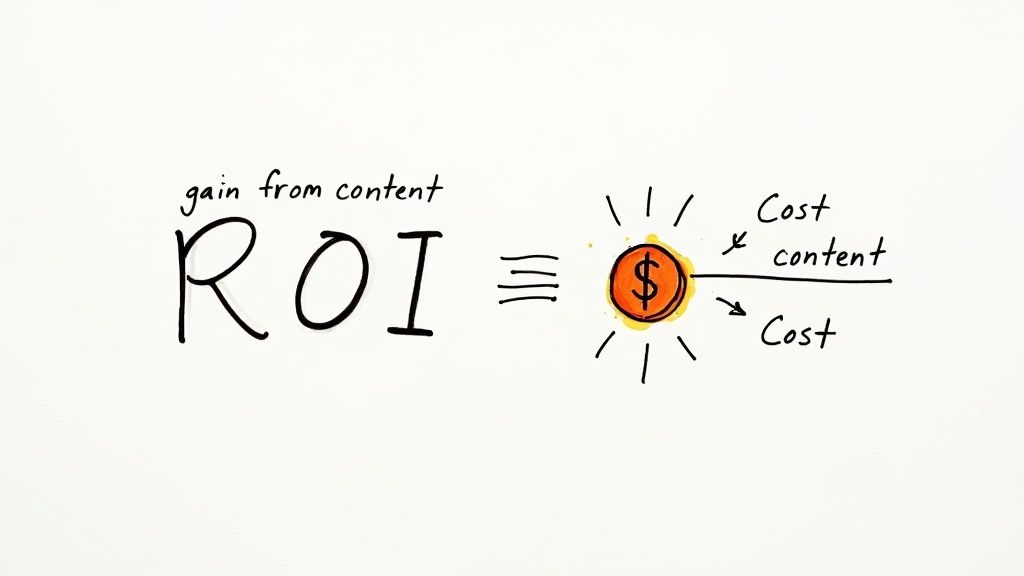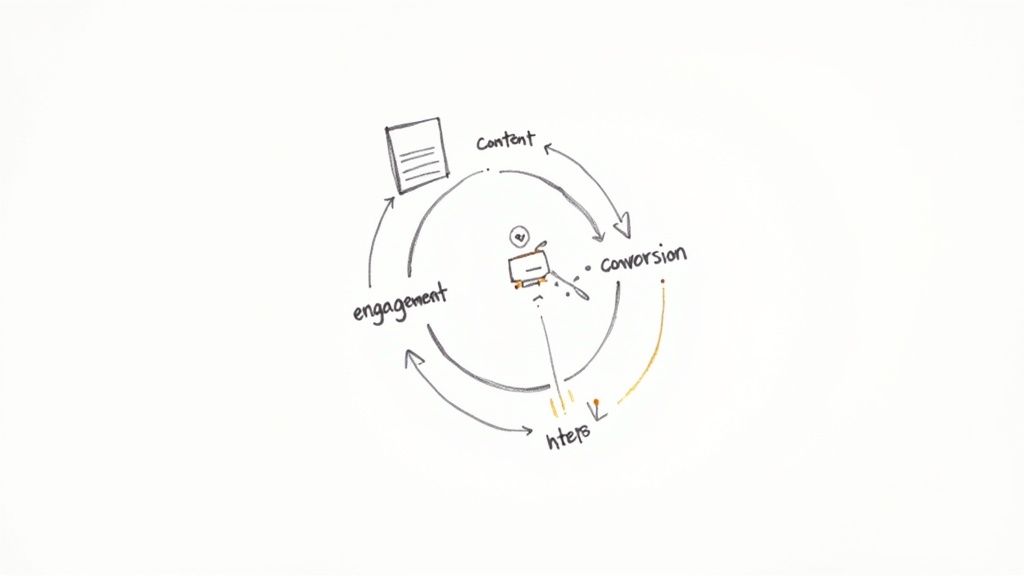ROI of Content Marketing: Your Complete Success Blueprint

14 mins
6/18/2025
Joe Ervin
- roi of content marketing
- content roi
- marketing measurement
- content strategy
- marketing metrics
Understanding Content Marketing ROI: Beyond Basic Metrics

If you're struggling to see the ROI of content marketing, you might be measuring it all wrong. Many business owners treat content like a paid ad campaign, expecting immediate, straight-line returns. This is a flawed approach that misses the point entirely.
Think of it this way: paid ads are like buying fruit at the grocery store. You get it right now, but the cost is high and the transaction is over. Content marketing is like planting an orchard. It requires time and patience, but it yields fruit for years, building a sustainable asset for your business.
The Dual Nature of Content Returns
The real value of content comes from two different kinds of returns: immediate gains and long-term equity. A single blog post can certainly generate quick leads, but its main job is to build a foundation for future growth.
This is why it helps to view your content strategy as an investment portfolio.
- Quick Wins: Certain pieces, like a targeted product guide or a timely social media post, can act like growth stocks, delivering a fast, visible return.
- Long-Term Compounders: Evergreen guides, foundational SEO articles, and brand-building stories are your blue-chip investments. They might not show huge returns overnight, but they steadily build brand equity, organic traffic, and customer trust, compounding their value over months and years.
Why Patience and Proper Tracking Are Non-Negotiable
This long-term compounding effect is precisely why patience is a marketer's best friend. You don't plant a seed on Monday and expect to harvest apples by Friday. The biggest myth about content marketing ROI is that it should be instant. In reality, the most meaningful returns build up over time as your content ranks on search engines, earns backlinks, and becomes a go-to resource.
The numbers back this up. High-quality content marketing generates three times the amount of leads as traditional outbound marketing while costing 62% less. This powerful combination of lead generation and cost savings is why a patient, strategic approach pays off so well. Discover more stats on content marketing effectiveness. This is a fundamental difference from paid advertising, where the traffic and leads stop the moment you turn off the budget. Your content orchard, however, keeps growing.
To capture this full picture, you must look beyond last-click sales. Calculating the true ROI of content marketing requires a mindset shift from viewing it as a short-term expense to recognizing it as a long-term business asset. It's about building an engine for growth that works for you 24/7, long after the initial investment is made. To do this, you need to track the right metrics that tell the complete story of your content's journey.
Essential Content ROI Metrics That Actually Drive Growth
It’s easy to get excited by a spike in page views, but that’s like celebrating a full house for a movie where everyone walks out in the first five minutes. A million visitors who don't stick around won't help your bottom line. To understand the real ROI of content marketing, you have to look past these vanity metrics and focus on performance indicators that signal genuine business growth. It's about tracking the entire customer journey, not just the first click.
Moving Beyond Vanity Metrics: A Tale of Two Indicators
Think of your content metrics like a car's dashboard. Some gauges show your current speed and engine temperature—these are your leading indicators. They tell you if you're on the right track in real-time. The odometer, which shows the total distance traveled, is your lagging indicator. It confirms you've reached your destination. To drive effectively, you need both.
Leading Indicators (The Journey): These are the early signs that your content is connecting with the right people. We're not just talking about traffic, but quality traffic. Key metrics here include time on page and scroll depth, which prove people are actually reading what you’ve written. Other vital signals are new email subscribers and newsletter sign-ups, which show your content is valuable enough for someone to invite you into their inbox.
Lagging Indicators (The Destination): This is where content proves its financial worth. These metrics draw a direct line from your content to your revenue. They include the number of marketing qualified leads (MQLs) generated from blog posts, conversion rates on landing pages linked from your content, and ultimately, the revenue attributed to your content marketing efforts.
How to Connect a Blog Post to a Bank Deposit
The path from a blog post to a sale is rarely a straight line. A customer might read three of your articles, see a social media post, and then finally make a purchase two months later. This is why models like last-click attribution are often misleading—they give 100% of the credit to the final touchpoint, ignoring the crucial role content played in building trust and awareness.
Instead, think about how your content influences the entire sales pipeline. Does a specific guide shorten the typical sales cycle? Does an in-depth case study lead to a higher average order value? Measuring this requires looking at the bigger picture of your marketing spend. You can even calculate a marketing efficiency ratio to see how your entire marketing engine is performing. This view ensures content gets the credit it deserves for warming up leads long before the final transaction.
To make this practical, let's break down which metrics matter most at each stage of the customer journey. Think of this table as a roadmap for your content measurement, guiding you from a stranger's first visit to a customer's final purchase.
Content Marketing Metrics by Funnel Stage
A comprehensive breakdown of key metrics to track at each stage of the customer journey, from awareness to advocacy.
| Funnel Stage | Primary Metrics | Secondary Metrics | ROI Impact |
|---|---|---|---|
| Awareness | Organic Traffic, Search Rankings (SERPs), Social Shares | Time on Page, Scroll Depth, New vs. Returning Visitors | Builds brand presence and fills the top of your funnel with a relevant audience. |
| Consideration | Email Sign-ups, Gated Content Downloads, Click-Through Rates (CTRs) | Comments & Engagement, Webinar Registrations, Time on Key Pages | Generates qualified leads and proves your content is valuable enough to trade contact information for. |
| Decision | Demo Requests, Free Trial Sign-ups, Conversion Rate on Sales Pages | Sales-Attributed Content, MQL-to-SQL Conversion Rate | Directly drives sales and can shorten the sales cycle by educating prospects before they talk to sales. |
| Advocacy | Customer Lifetime Value (CLV), Repeat Purchase Rate, Referral Traffic | User-Generated Content (UGC), Positive Reviews, Social Media Mentions | Creates brand loyalists who increase profitability and drive new business through word-of-mouth. |
By tracking metrics across the entire funnel, you get a complete story. You can see not only where your content generates direct revenue but also how it builds the foundation of trust and authority that makes those sales possible in the first place.
This balanced approach takes you beyond guesswork. It helps you build a performance picture that tells a compelling ROI story, justifies your budget, and guides every content decision you make toward tangible business growth.
Calculating Content Marketing ROI: Formulas That Work

Once you have your key metrics, it’s time to connect your content to real business results. This is the moment you move beyond tracking page views and start proving financial value. Calculating the ROI of content marketing is about translating your efforts into the language of the C-suite: money. It’s how you turn your content team from a cost center into a proven revenue driver.
The Basic ROI Formula, Adapted
At its core, the formula is straightforward. It’s a standard business equation that we can adapt for our content.
ROI = [(Return - Investment) / Investment] x 100
The final number is a percentage. If you get 100%, you’ve earned back every dollar you spent. Anything above that is pure profit. The real challenge isn’t the calculation itself; it's accurately defining "Return" and "Investment" for your content efforts.
Investment: This is the most direct part of the equation. It includes all the hard costs that went into creating and promoting your content. Think of freelance writer fees, design expenses, your subscription to an SEO tool like Ahrefs, and your ad spend. You should also include the prorated salaries of your in-house team members for the time they spent on the project.
Return: This is where the real detective work begins. The return is the total value your content generated. While a direct sale is easy to track, most content plays a supporting role in a much longer customer journey. Your job is to trace its influence and assign a dollar value to the actions it drives.
Putting a Price Tag on Your Content's Success
To calculate a realistic return, you need to connect your content's performance to actual dollars. It's less about direct sales and more about tracing the journey a customer takes after engaging with your work.
Let's walk through an example. Imagine one of your blog posts generated 50 new email subscribers. Looking at your historical data, you know that about 10% of your email subscribers eventually make a purchase. You also know your average customer lifetime value (CLV) is $1,000.
With these numbers, we can connect the dots:
- Projected customers from the post: 50 subscribers x 10% conversion rate = 5 new customers
- Total projected value: 5 customers x $1,000 CLV = $5,000 Return
If the total investment to create and promote that blog post was $1,000, your ROI would be a very healthy 400%. This approach transforms a "soft" metric like email sign-ups into a hard number that demonstrates clear business impact.
Choosing the Right Calculation Method
The right way to calculate your return depends entirely on your business model. A B2B software company with a long sales cycle will measure value very differently from an e-commerce store selling t-shirts. The goal is to choose a formula that mirrors how your customers actually interact with and buy from your brand.
To help you choose, here are a few common calculation methods broken down by what they do best.
Content Marketing ROI Calculation Methods
Different formulas and approaches for calculating ROI based on business model and available data.
| Calculation Method | Best For | Formula | Complexity Level |
|---|---|---|---|
| Direct Revenue Attribution | E-commerce, Direct-Response | (Revenue from Content - Content Cost) / Content Cost | Low |
| Lead Value Attribution | B2B, High-Ticket Services | (Total Lead Value - Content Cost) / Content Cost | Medium |
| CLV-Based ROI | Subscription, Repeat Purchase Models | (CLV from Content - Content Cost) / Content Cost | High |
| Assisted Conversion Value | Complex Customer Journeys | (Value of Assisted Conversions - Content Cost) / Content Cost | High |
Using a structured formula like one of the above ensures you're measuring genuine business impact, not just clicks and views. It shifts the conversation from "how many people saw our blog post?" to "how much revenue did that post generate?" This focus is critical for proving your team's contribution to the bottom line.
Industry Benchmarks and Realistic ROI Expectations
After seeing the formulas, you’re probably asking the big question: what’s a good number? The reality is, the ROI of content marketing isn't a one-size-fits-all metric. Comparing a B2B SaaS startup with a year-long sales cycle to an e-commerce giant selling t-shirts is like comparing the growth of a redwood sapling to a sunflower. Both are growing, but on vastly different timelines and scales.
Your industry, business model, and how long you've been in the game all shape your unique financial picture.
Why Your Industry Dictates Your ROI Timeline
The most significant factor influencing your ROI expectations is your industry's sales process. How long it takes to make a sale and how much that sale is worth will dramatically change when and how you see a return.
Sales Cycle: Think of the customer journey. For a t-shirt brand, a blog post might spark a sale in a few hours. For an enterprise software company, content is more like a slow courtship, nurturing a relationship with guides and webinars over a 6-12 month period before a deal is ever signed. The ROI is there, but it's delayed.
Deal Size: A company selling $50,000 software contracts only needs a few conversions to prove a massive ROI. But earning that kind of trust requires a long-term strategy focused on building authority, not just chasing quick sales.
Market Maturity: If you’re a new player in a crowded space, your first content efforts are about planting a flag and building credibility. This foundational work has to come before you can expect major financial returns.
Setting Realistic Goals for Your Business
Beyond industry trends, your own company’s context is key to setting achievable goals. A brand with a five-year-old blog and a dedicated team will naturally have a higher baseline ROI than a startup publishing its very first post. This concept is known as content marketing maturity.
For B2B companies playing the long game with strategies like blogging and white papers, the eventual payoff can be substantial. While it demands patience, some reports show that mature content marketing can eventually bring in an incredible $42 for every $1 spent. This highlights the immense value built over time by establishing deep expertise and trust. Explore more powerful content marketing stats.
Ultimately, the most important benchmark is your own past performance. Instead of chasing an arbitrary industry number, focus on improving your own ROI month over month. A positive trend line is a far better indicator of a successful content program than trying to match the isolated results of a completely different business.
High-ROI Content Formats and Distribution Strategies

Getting a great return on your content marketing isn’t about publishing more; it’s about creating the right content and getting it in front of the right people. Not all content is created equal. Some formats consistently pull more weight because they are better at solving customer problems and building genuine, lasting trust.
Choosing Your High-Performance Formats
Think of your content formats like tools in a toolbox. A quick blog post is a handy screwdriver, but a deep, comprehensive guide is a full power-drill set. Formats like in-depth guides, original research, and customer case studies often deliver the best ROI because they establish your authority and answer the exact questions your ideal customers are searching for. They solve big problems, turning your brand into an essential resource.
For instance, marketing software companies like HubSpot build much of their strategy around powerful, evergreen guides. This content attracts high-quality organic traffic for years, acting as a reliable engine for new leads. The upfront work pays for itself many times over by continually capturing prospects who are actively looking for answers.
Video has also become a powerful tool for high-return strategies. In particular, short-form video is an incredibly efficient way to grab attention and spark engagement. According to recent data, 21% of marketers report that short-form videos provide the highest ROI of any content format. You can discover more in HubSpot's latest marketing report.
Smart Distribution for Maximum Returns
Creating a brilliant piece of content is only half the battle. If a masterpiece sits in a dark room, no one can appreciate it. Without a clear distribution plan, even the best guide will fail to generate a return. A winning strategy uses a mix of three core channels:
- Owned Media: This is your home turf—your blog, email list, and social media profiles. You have full control here.
- Earned Media: This is word-of-mouth gold—organic mentions, press features, and social shares from your audience that build credibility.
- Paid Promotion: This involves putting a strategic ad budget behind your best content to introduce it to new, targeted audiences.
The real secret to multiplying your return is content repurposing. Think of it like cooking a Thanksgiving turkey. The main meal is the big event, but you can use the leftovers for sandwiches, soup, and stock for days. You get maximum value out of a single effort. For example, one comprehensive guide can be broken down into:
- A ten-part email course
- A series of short social media videos
- An infographic highlighting key data points
- Several shorter blog posts that expand on individual sections
This approach turns one big investment into a dozen smaller marketing assets, increasing the reach of your campaign and driving down the cost of acquiring each lead. It’s a system that lets you connect with different people on the platforms they actually use. This is a vital tactic for any business, and you can dive deeper in our guide on content marketing for e-commerce. By pairing the right formats with a smart, repurposing-first distribution plan, you create a repeatable system for growth.
Advanced Techniques for Maximizing Content ROI
 After you get the basics down, you can start using next-level techniques that make your content stand out. Top-performing teams use these methods to get the most value from their efforts, giving them a real edge and boosting their content marketing ROI.
After you get the basics down, you can start using next-level techniques that make your content stand out. Top-performing teams use these methods to get the most value from their efforts, giving them a real edge and boosting their content marketing ROI.
Go Beyond Last-Click with Advanced Attribution
Thinking that the last click before a sale gets all the credit is like only celebrating the person who scored the basket, ignoring the player who made the perfect pass. Your content is often that perfect pass, setting up the easy shot.
This is especially true for businesses with longer sales cycles. Imagine a customer buying premium skincare. They might read your blog post on active ingredients, watch an Instagram story a week later, and finally click a retargeting ad to make a purchase. Multi-touch attribution gives you a view of this entire path.
It assigns value to each of those steps, making sure your helpful blog posts and guides get credit for introducing and nurturing potential customers.
Implement a Systematic Testing Framework
To get real improvements in your content ROI, you need to go beyond basic A/B testing. Think of it like running a science lab for your content, where you're constantly forming hypotheses and running organized experiments to find what truly works.
Instead of making random changes and hoping for the best, a systematic testing framework allows you to test significant variables on a schedule. This creates a loop of constant learning, where each test gives you insights for the next one. Here are a few high-impact experiments to get you started:
- Headline Variations: Don't just swap a few words. Test entirely different emotional hooks or angles to see what compels people to click from a search results page.
- Content Depth: Is a 3,000-word ultimate guide better than a quick 800-word summary? Test them against each other to find out what your audience actually prefers for different topics.
- Call-to-Action (CTA) Placement: Try putting your main CTA at the very beginning of an article, in the middle, or only at the end. You might be surprised where it performs best.
- Audience Personalization: Serve one version of an article to first-time visitors and a slightly different one to loyal, returning customers. Then, measure which group engages more deeply.
Build Systems to Scale Quality with Quantity
As your content program grows, its biggest enemy is a slow decline in quality. When you start publishing more, it's easy to let standards slide, which can sink your ROI. The solution isn't just more effort; it’s building repeatable systems.
The most successful content teams operate on clear documentation, not guesswork. They build a Content Quality Playbook—a central document that outlines exactly how things are done.
This playbook includes detailed content briefs that define the audience, keywords, business objective, and tone for every article. Paired with checklists for editing, SEO, and promotion, this process ensures every piece of content meets your standards before it goes live.
This structured method makes quality something you can scale. It ensures your 100th blog post is as thoughtful and effective as your first, protecting your brand and delivering consistent results from your investment.
Building Sustainable ROI-Focused Content Operations
Achieving a consistent, positive ROI of content marketing isn't about landing a few viral hits. It's about shifting your approach from an art studio chasing sporadic creative wins to a factory built for efficiency and quality. The goal is to create a predictable system that treats content as a strategic business asset, one designed to generate compounding returns over time.
This operational mindset ensures every piece of content has a job. Your editorial calendar stops being a simple publishing schedule and becomes a strategic roadmap. Each article, video, or guide is directly tied to a business goal, whether that’s acquiring new customers or improving retention.
The Core Components of an ROI-Driven System
To build this content machine, you must balance your efforts across three critical areas. Many teams pour all their energy into creation and neglect the other two, which crushes potential returns. A sustainable operation allocates resources thoughtfully across the entire content lifecycle.
- Strategic Creation: This is more than just writing. It involves deep audience research, picking topics with clear business potential (like those targeting high-intent keywords), and using detailed content briefs to ensure every piece meets a high standard of quality.
- Systematic Promotion: Great content that nobody sees has zero ROI. This means having a repeatable checklist for distribution that goes far beyond a single social media post. It should include email marketing, targeted outreach for backlinks, and repurposing content for different channels.
- Continuous Optimization: Your content’s job doesn’t end at publication. The most successful teams dedicate 20% of their time to refreshing older, high-potential posts. This simple act can boost search rankings, keep information relevant, and maximize your initial investment.
Scaling Quality to Protect Your Returns
As you produce more content, the biggest threat to your ROI is a drop in quality. The key to scaling without sacrificing quality is to build documented systems. Create a central playbook that holds your brand’s style guide, SEO best practices, and promotion checklists. This documentation empowers your team to work with confidence while ensuring every asset aligns with your strategy.
This structured approach makes it easier to track performance and connect content results to broader business goals. By focusing on evergreen strategies and systematic audience building, you create an asset that appreciates in value. These principles are especially important in competitive markets; you can see how they apply in our detailed guide on developing an ecommerce content strategy. Evolving how you measure success ensures you always have a clear, data-backed view of your content's financial impact, cementing its role as a key growth driver.





